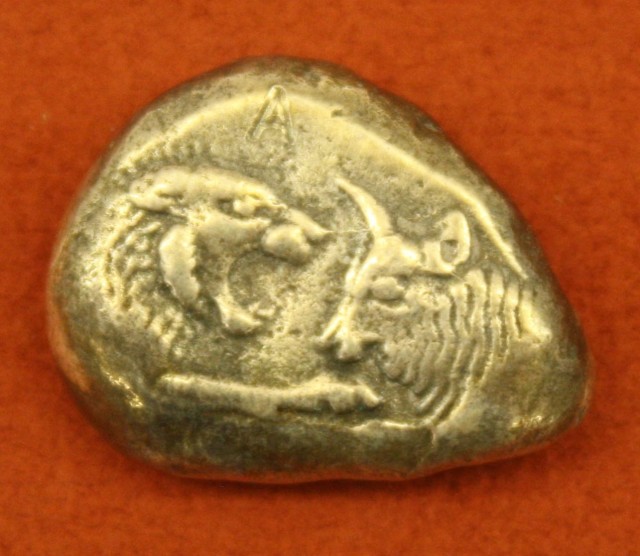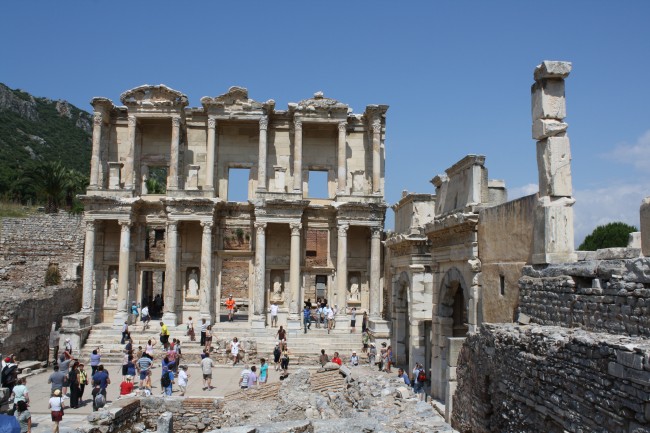
| ASIA MINOR Asia Minor Maps :
Ancient Asia Minor is a geographic region located in the south-western part of Asia comprising most of what is present-day Turkey. The earliest reference to the region comes from tablets of the Akkadian Dynasty (2334-2083 BCE) where it is known as 'The Land of the Hatti' and was inhabited by the Hittites. The Hittites themselves referred to the land as 'Assuwa' (or, earlier, Aswiya) which actually only designated the area around the delta of the river Cayster but came to be applied to the entire region. Assuwa is considered the Bronze Age origin for the name 'Asia' as the Romans later designated the area. It was called, by the Greeks, 'Anatolia' (literally, 'place of the rising sun', for those lands to the east of Greece).
Name
& Regions :
In the ancient world, Asia Minor was the seat of the kingdoms and cities of :
•
Thrace
Famous
Sites & People :
Lydian silver stater from the reign of Croesus, 560 - 546 BCE. O: Foreparts of a lion and ox. (R: Two incuse squares). By Mark Cartwright (CC BY-NC-SA)
Mythology & History :
Between 1250 and 1200 BCE the Sea Peoples invaded from the south, making incursions into Greece, harassing Egypt, and finally driving the Hittites from the region of Assuwa. The Sea Peoples did not remain to colonize the area, however (at least not to any important degree) and eventually moved on to settle, in part, to the south in Canaan. Greek colonists, mainly from Athens and surrounding Attica, settled the coastline of Asia Minor from the Mediterranean up to the Black Sea. It was these Ionian colonies which, supported and funded by Athens and Eretria, rose in revolt when the area came under Persian control, provoking the wrath of the Persian king Darius I and the first invasion of Greece in 490 BCE which was repelled at the Battle of Marathon.
Library of Celsus, Ephesus by Mark Cartwright (CC BY-NC-SA) Completed in 117 CE, the Library of Celsus at Ephesus was ordered built by Tiberius Julius Acquila in memory of his father Tiberius Julius Celsus Polemaeanus, proconsul (governor) of the Asian province c. 105 to 114 CE.
Alexander the Great defeated the Persians in 334-333 BCE and conquered Asia Minor. In Gordium, capital of Phrygia, he is claimed to have famously cut the Gordian Knot which the oracles claimed meant Alexander would be king of Asia. Following his death, the land was governed by his general Antigonus I in the north and west and his other general Seleucus I Nicator to the south and east and was prominently involved in the Wars of the Diadochi (the wars of Alexander's successors). The region remained unstable throughout the rule of the Hellenistic governors until the coming of Rome in 133 BCE (King Attalus III of Pergamon left his city the Roman Republic in his will and thus invited the Roman presence into the region). After 133 BCE, Rome steadily conquered or annexed the cities of Asia Minor until it was wholly a Roman province.
Under Roman rule, the land became stabilized; roads were built and the infrastructures of many of the cities improved. The coastal communities flourished and Ephesus, especially, enjoyed great prosperity until the rise of Christianity when 'earthly' advances in the region were neglected in anticipation of the Second Coming of Christ. The Byzantine Empire controlled the region after the fall of the Roman Empire in 476 CE and, after the rise of Islam, the later Byzantine Christians fought the Islamic Caliphates for the land until the coming of the Seljuq Turks in 1068 CE. Turkish control increased in the region until 1299 CE when Asia Minor became part of the Ottoman Empire and, after its collapse, became Turkey.
Source :
https://www.ancient.eu/ |




